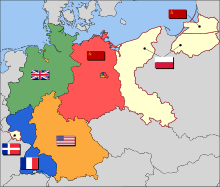This article needs additional citations for verification. (December 2012) |

The Bizone (German: [ˈbiːˌt͡soːnə] ) or Bizonia[1] was the combination of the American and the British occupation zones on 1 January 1947 during the occupation of Germany after World War II. With the addition of the French occupation zone on 1 August 1948[2][3] the entity became the Trizone[4] (German: [ˈtʁiːˌt͡soːnə] ; sometimes jokingly called Trizonesia (German: Trizonesien, German pronunciation: [tʁit͡soˈneːzi̯ən] )[5]). Later, on 23 May 1949, the Trizone became the Federal Republic of Germany, commonly known as West Germany.
- ^ Encyclopædia Britannica
- ^ "The division of Germany". Centre Virtuel de la Connaissance sur l'Europe. The University of Luxembourg. Retrieved 31 July 2019.
- ^ J. Robert Wegs & Robert Ladrech (1996). Europe since 1945: a concise history. New York.
- ^ Hans Georg Lehmann, Chronik der Bundesrepublik Deutschland 1945/49 bis 1981, Munich: Beck, 1981, (Beck'sche Schwarze Reihe; Vol. 235), ISBN 3-406-06035-8, p. 18.
- ^ As, for example, in a well-known Karneval song from that time, the "Trizonesien-Song".